Physical and Numerical Modeling of the Stability of Deep Caverns in Tahe Oil Field in China
Abstract
:1. Introduction
2. Test
2.1. Test Equipment
2.2. Test Material
2.3. Test Procedures
3. Result of the Model Test
3.1. Cave Collapse and Failure Process
3.2. Change Rules of Displacement and Stress around the Cavern
4. Numerical Analysis and Verification
4.1. Numeric Calculation Model
4.2. Analysis of Calculation Results
5. Conclusions
- The ultra-high pressure test equipment is developed, which can be used to carry out experimental research to study the collapse of the cave with a depth of more than 5000 m.
- Based on the theory of similarity, the model similar material which meets the similitude conditions with the prototype rock is developed in terms of the deformation characteristics as well as the strength failure characteristics. The mass ratio of iron powder, barite powder and quartz sand is 1:0.67:0.25. The concentration of rosin alcohol solution is 17%. The weight of rosin alcohol solution is 6% of the similar material total weight.
- The failure mechanism of the cave is determined through the model test and numerical calculations: the collapse process starts from the cracks emerging on left and right walls; then, the cracks run through the top, eventually causing the final collapse and failure. Shear failure is the primary failure mode, and the damage scope is 2.3 times as long as the cave span.
Acknowledgments
Author Contributions
Conflicts of Interest
References
- Huang, Z.Q.; Yao, J.; Wang, Y.Y. An efficient numerical model for immiscible two-Phase flow in fractured karst reservoirs. Commun. Comput. Phys. 2013, 13, 540–558. [Google Scholar] [CrossRef]
- Li, S.; Kang, Y.L.; Li, D.Q.; Lian, Z.H. Experimental and numerical investigation of multiscale fracture deformation in fractured–vuggy carbonate reservoirs. Arab. J. Sci. Eng. 2014, 39, 4241–4249. [Google Scholar] [CrossRef]
- Zhao, W.Z.; Shen, A.J.; Hu, S.Y.; Zhang, B.M; Pan, W.Q.; Zhou, J.G.; Wang, Z.C. Geological conditions and distributional features of large-scale carbonate reservoirs onshore China. Petrol. Explor. Dev. 2012, 39, 1–14. [Google Scholar] [CrossRef]
- Huang, Z.Q.; Yao, J.; Li, Y.J.; Wang, C.C.; Lv, X.R. Numerical calculation of equivalent permeability tensor for fractured vuggy porous media based on homogenization theory. Commun. Comput. Phys. 2011, 9, 180–204. [Google Scholar] [CrossRef]
- Xu, X.; Tian, S.S.; Xu, T.; Su, Y.X. The equivalent numerical simulation of fractured-vuggy carbonate reservoir. Appl. Mech. Mater. 2012, 110–116, 3327–3331. [Google Scholar] [CrossRef]
- Kang, Y.Z. Characteristics and distribution laws of paleokarst hydrocarbon reservoirs in palaeozoic carbonate formations in china. Nat. Gas Ind. 2008, 28, 1–12. [Google Scholar]
- Dong, Z.; Alfen, L.; Jun, Y. A single-phase fluid flow pattern in a kind of fractured-vuggy media. Pet. Sci. Technol. 2011, 29, 1030–1040. [Google Scholar] [CrossRef]
- Li, Y. The theory and method for development of carbonate fracture-cavity reservoirs in Tahe oilfield. Acta Pet. Sin. 2013, 34, 115–121. [Google Scholar]
- Zhou, H.; Wang, C.; Han, B; Duan, Z. A creep constitutive model for salt rock based on fractional derivatives. Int. J. Rock Mech. Min. Sci. 2011, 48, 116–121. [Google Scholar] [CrossRef]
- Nazary, M.S.; Nazokkar, K.; Chalaturnyk, R.J.; Mirzabozorg, H. Parametric assessment of salt cavern performance using a creep model describing dilatancy and failure. Int. J. Rock Mech. Min. Sci. 2015, 79, 250–267. [Google Scholar]
- Wang, T.; Yang, C.; Ma, H. Safety evaluation of salt cavern gas storage close to an old cavern. Int. J. Rock Mech. Min. Sci. 2016, 83, 95–106. [Google Scholar] [CrossRef]
- Duan, K.; Kwokc, C. Evolution of stress-induced borehole breakout in inherently anisotropic rock: Insights from discrete element modeling. J. Geophys. Res. Solid Earth 2016, 121, 2361–2381. [Google Scholar] [CrossRef]
- Wang, T.; Yang, C.; Shi, X. Failure analysis of thick interlayer from leaching of bedded salt caverns. Int. J. Rock Mech. Min. Sci. 2015, 73, 175–183. [Google Scholar] [CrossRef]
- Wang, G.; Guo, K.; Christianson, M.; Konietzky, H. Deformation characteristics of rock salt with mudstone interbeds surrounding gas and oil storage cavern. Int. J. Rock Mech. Min. Sci. 2011, 48, 871–877. [Google Scholar] [CrossRef]
- Ma, D.; Rezania, M.; Yu, H.S.; Bai, H.B. Variations of hydraulic properties of granular sandstones during water inrush: Effect of small particle migration. Eng. Geol. 2017, 217, 61–70. [Google Scholar] [CrossRef]
- Zhou, Z.; Cai, X.; Cao, W.; Li, X.; Xiong, C. Influence of water content on mechanical properties of rock in both saturation and drying processes. Rock Mech. Rock Eng. 2016, 49, 3009–3025. [Google Scholar] [CrossRef]
- Ma, D.; Li, Q.; Hall, M.R.; Wu, Y. Experimental investigation of stress rate and grain size on gas seepage characteristics of granular coal. Energies 2017, 10, 527. [Google Scholar] [CrossRef]
- Zhou, Z.; Cai, X.; Chen, L.; Cao, W.; Zhao, Y.; Xiong, C. Influence of cyclic wetting and drying on physical and dynamic compressive properties of sandstone. Eng. Geol. 2017, 220, 1–12. [Google Scholar] [CrossRef]
- Ma, D.; Miao, X.X.; Wu, Y.; Bai, H.B.; Wang, J.G.; Rezania, M.; Huang, Y.H.; Qian, H.W. Seepage properties of crushed coal particles. J. Pet. Sci. Eng. 2016, 146, 297–307. [Google Scholar]
- Zhang, Q.Y.; Duan, K.; Jiao, Y.Y.; Xiang, W. Physical model test and numerical simulation for the stability analysis of deep gas storage cavern group located in bedded rock salt formation. Int. J. Rock Mech. Min. Sci. 2017, 94, 43–54. [Google Scholar] [CrossRef]
- Zhang, Q.Y.; Zhang, X.T.; Wang, Z.C.; Xiang, W.; Xue, J.H. Failure mechanism and numerical simulation of zonal disintegration around a deep tunnel under high stress. Int. J. Rock Mech. Min. Sci. 2017, 93, 344–355. [Google Scholar] [CrossRef]
- Zhu, W.S.; Li, Y.; Li, S.C.; Wang, S.J.; Zhang, Q.B. Quasi-three-dimensional physical model tests on a cavern complex under high in-situ stresses. Int. J. Rock Mech. Min. Sci. 2011, 48, 199–209. [Google Scholar]
- Huang, F.; Zhu, H.; Xu, Q.; Cai, Y.; Zhuang, X. The effect of weak interlayer on the failure pattern of rock mass around tunnel-scaled model tests and numerical analysis. Tunn. Undergr. Space Technol. 2013, 35, 207–218. [Google Scholar] [CrossRef]
- Zhang, Q.B.; He, L.; Zhu, W.S. Displacement measurement techniques and numerical verification in 3D geomechanical model tests of an underground cavern group. Tunn. Undergr. Space Technol. 2016, 56, 54–64. [Google Scholar] [CrossRef]
- Liu, Y.; Guan, F.; Yang, Q.; Yang, R.; Zhou, W. Geomechanical model test for stability analysis of high arch dam based on small blocks masonry technique. Int. J. Rock Mech. Min. Sci. 2013, 61, 231–243. [Google Scholar] [CrossRef]
- Ghabraie, B.; Ren, G.; Zhang, X.; Smith, J. Physical modelling of subsidence from sequential extraction of partially overlapping longwall panels and study of substrata movement characteristics. Int. J. Coal Geol. 2015, 140, 71–83. [Google Scholar] [CrossRef]
- Fei, W.P.; Zhang, L.; Zhang, R.; Yang, R. Experimental study on a geo-mechanical model of a high arch dam. Int. J. Rock Mech. Min. Sci. 2010, 47, 299–306. [Google Scholar] [CrossRef]

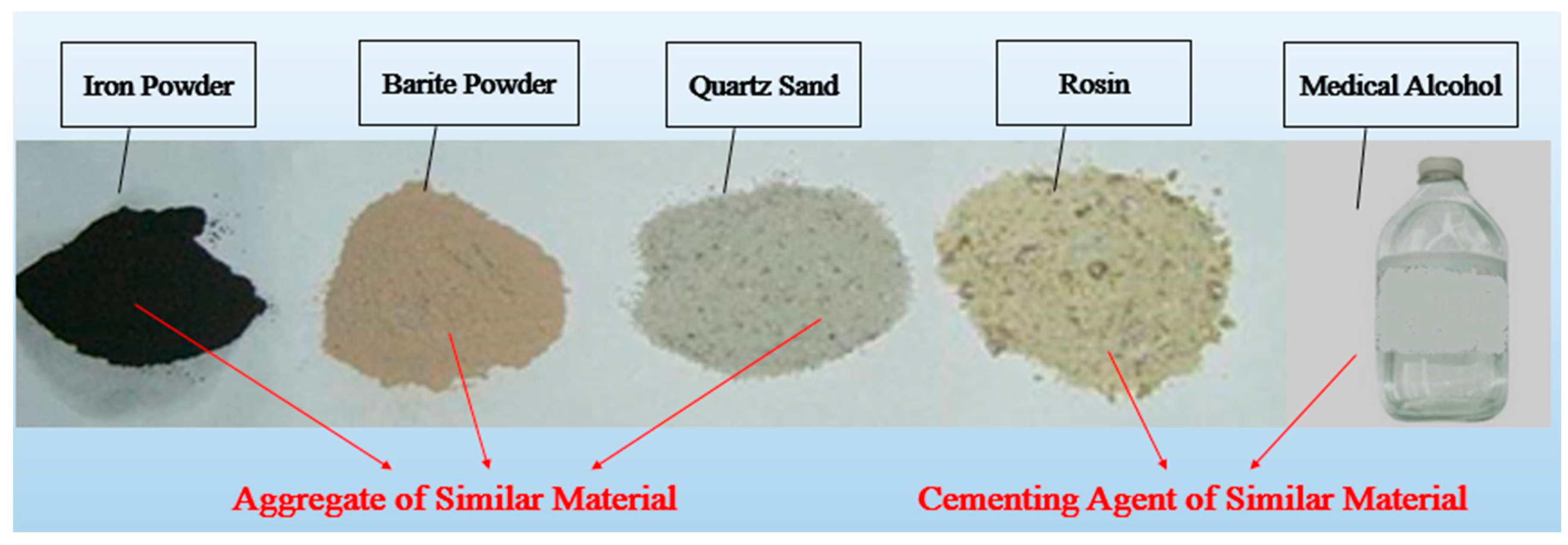
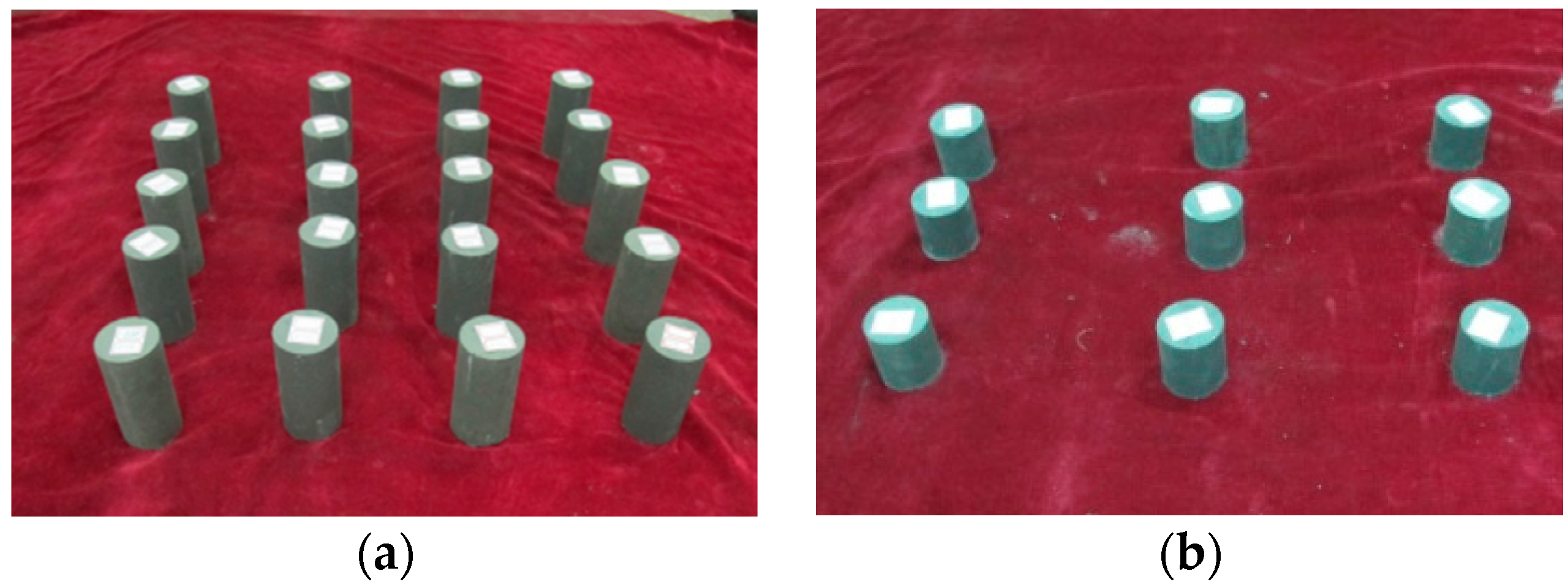


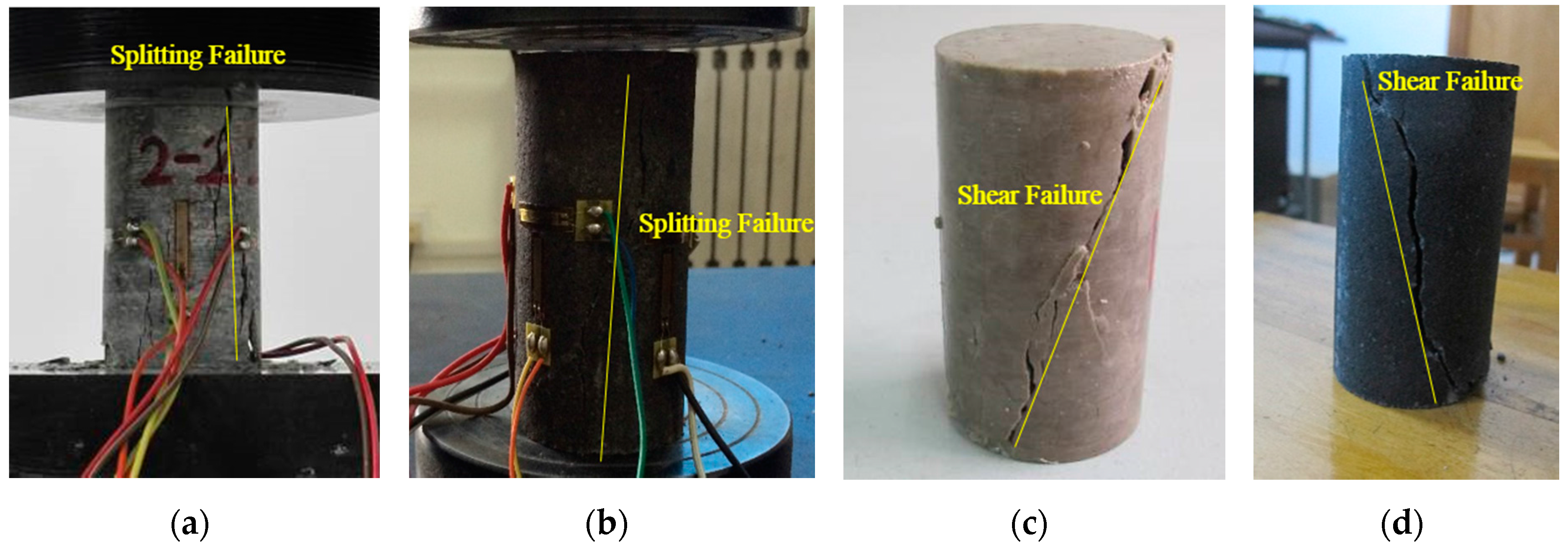
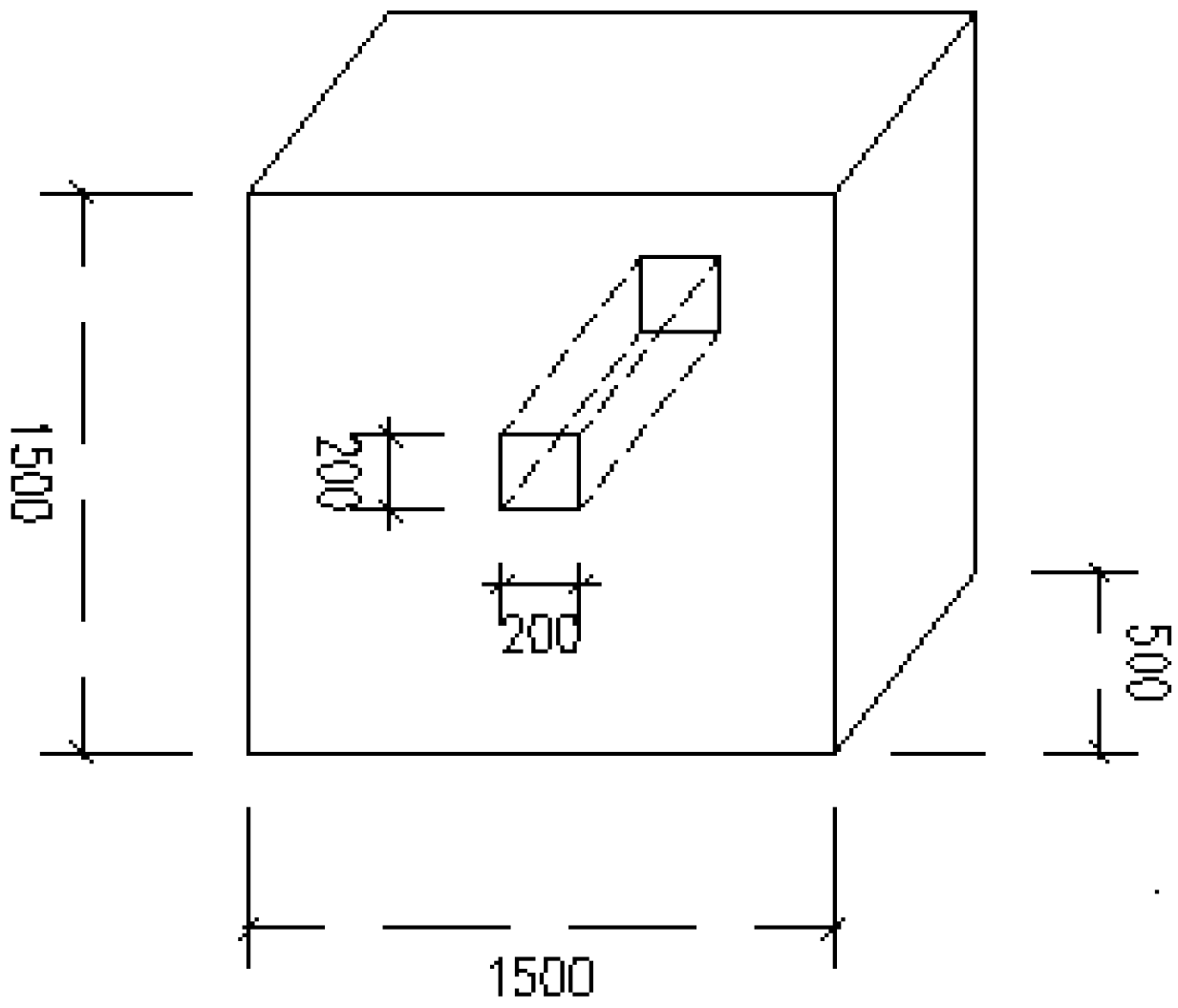
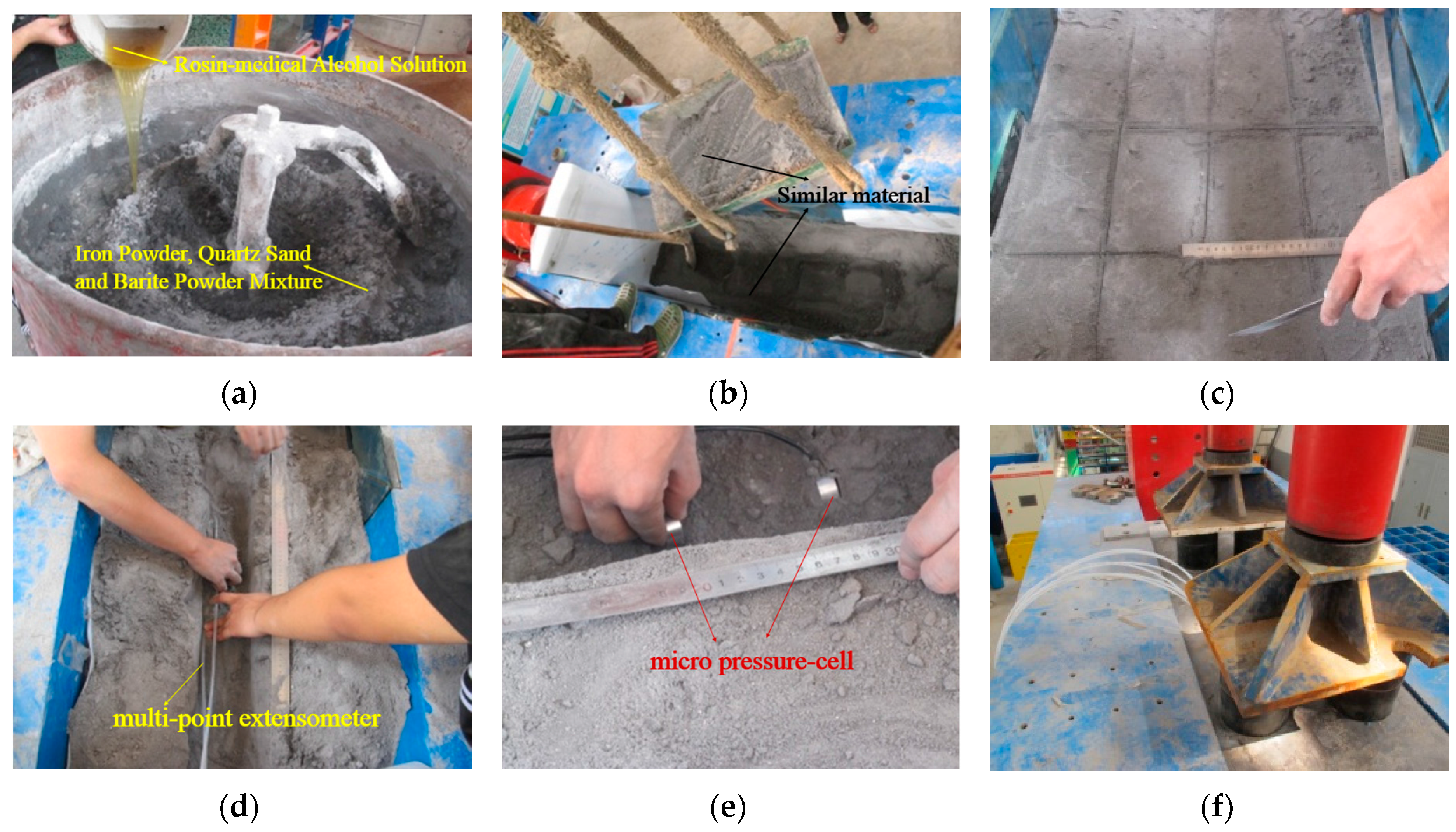
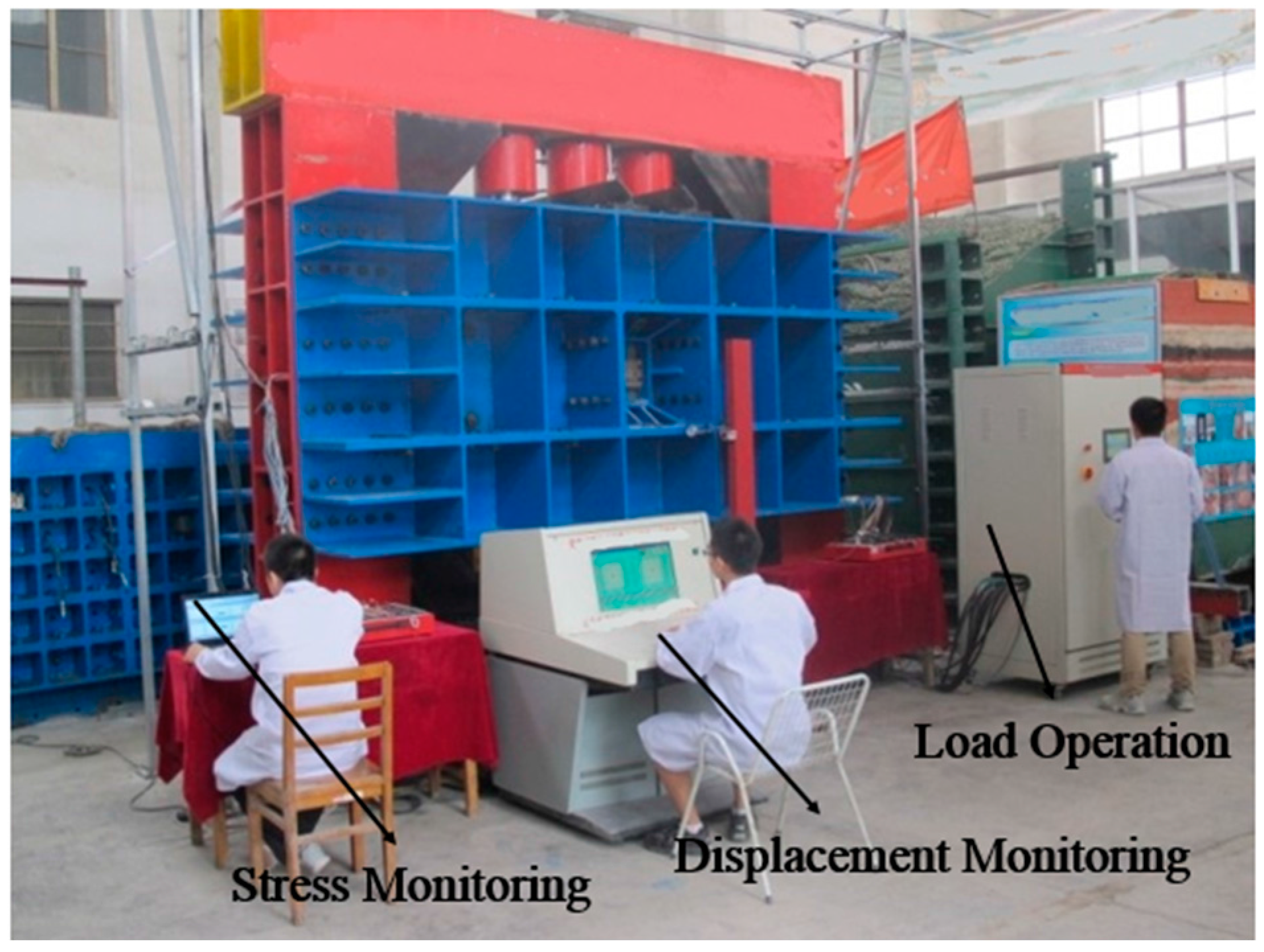
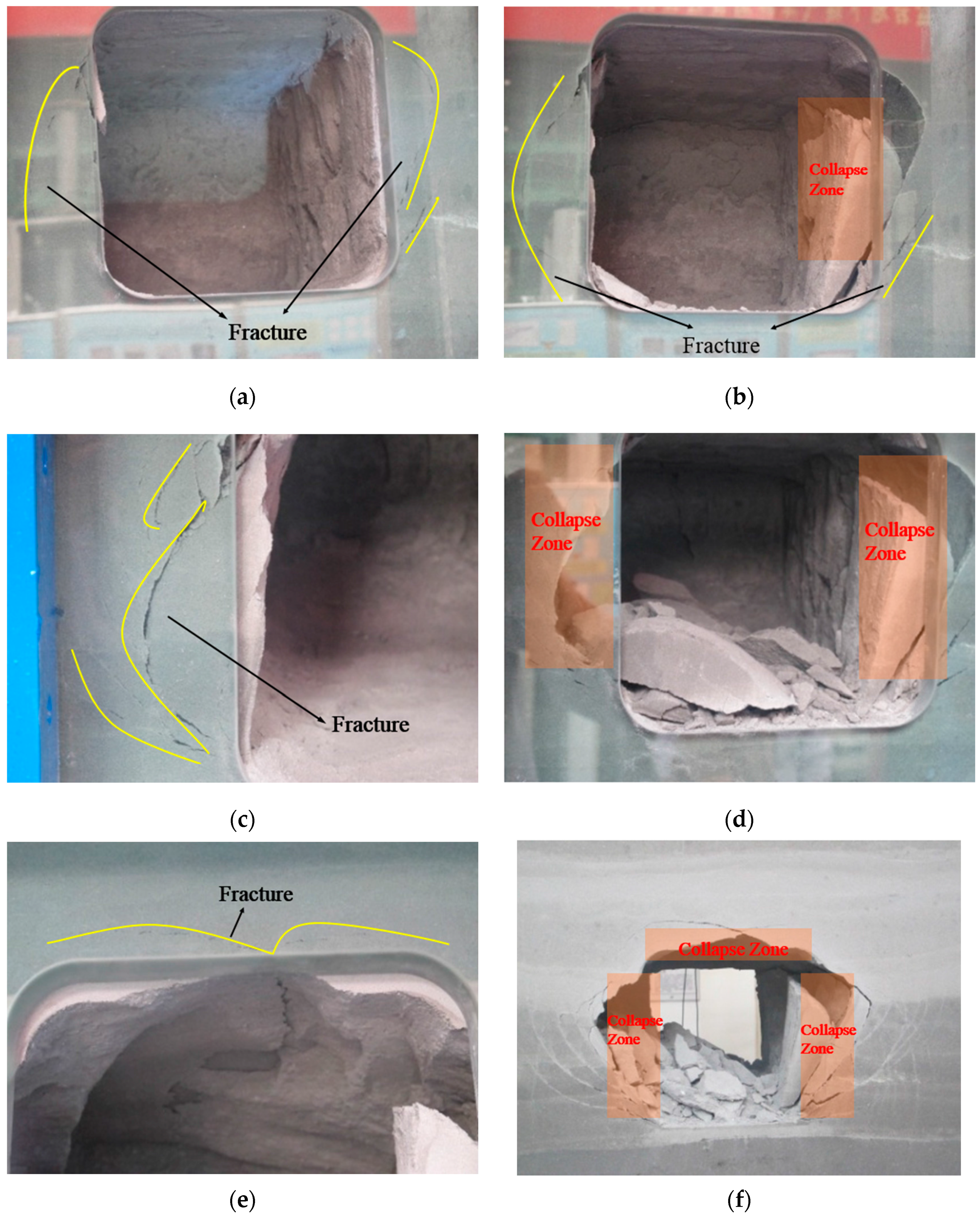
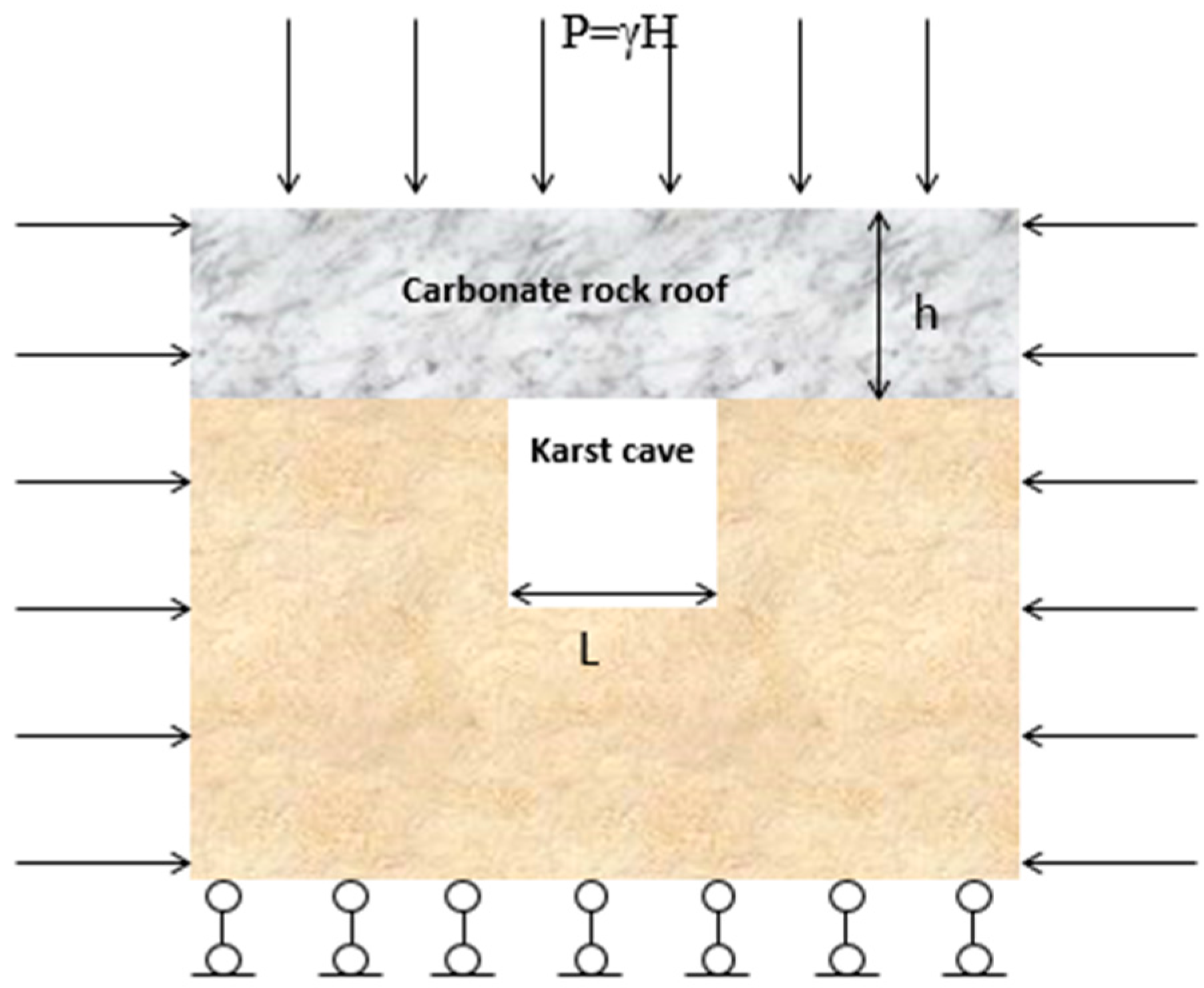
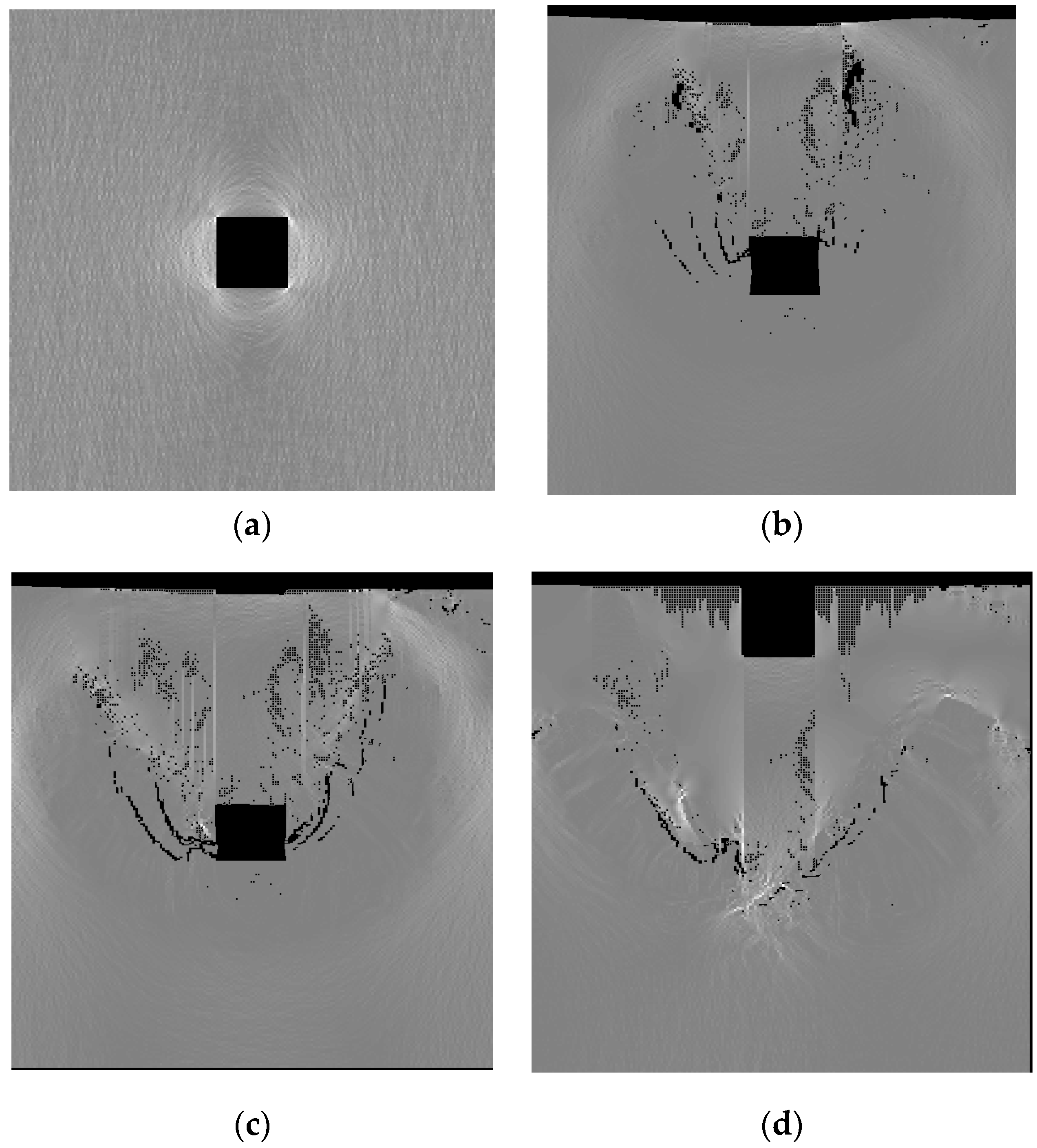
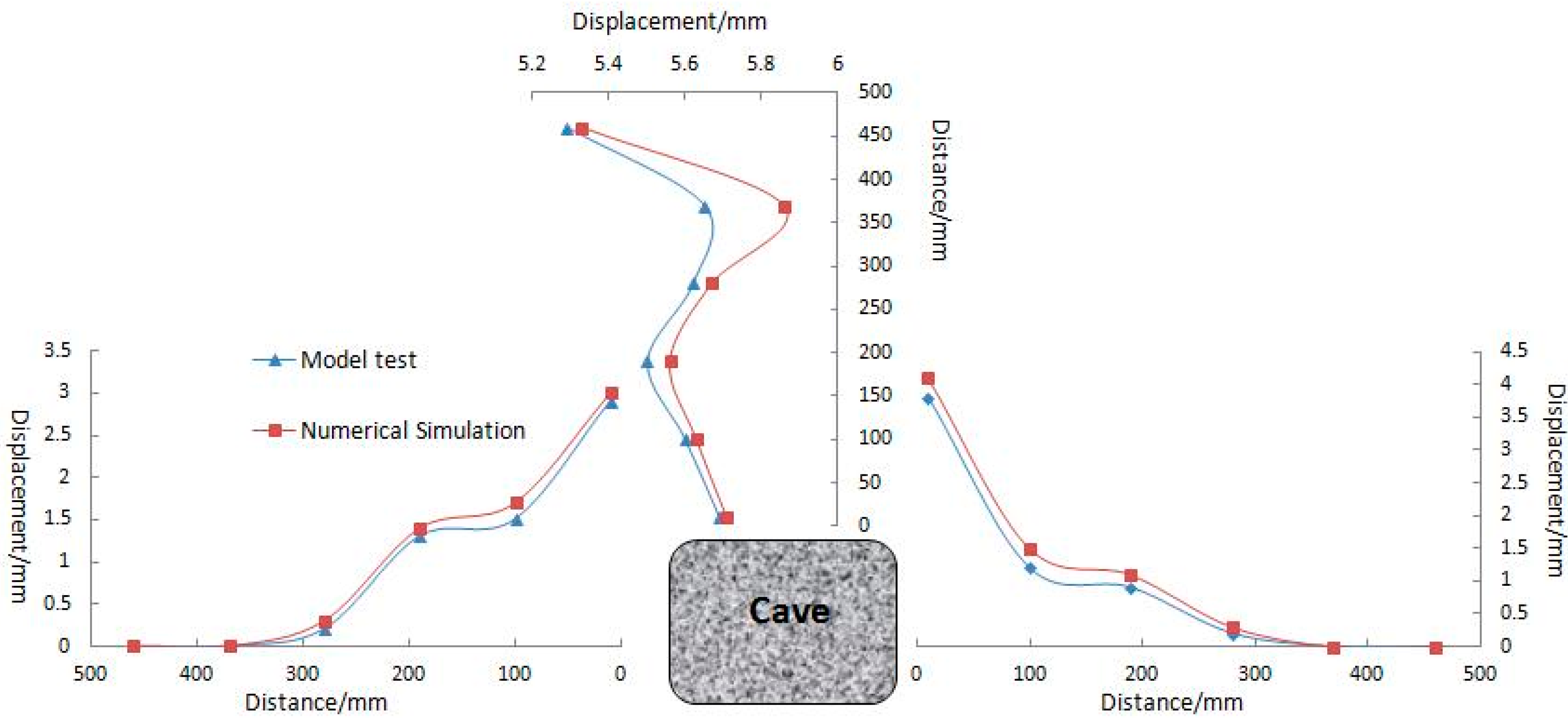
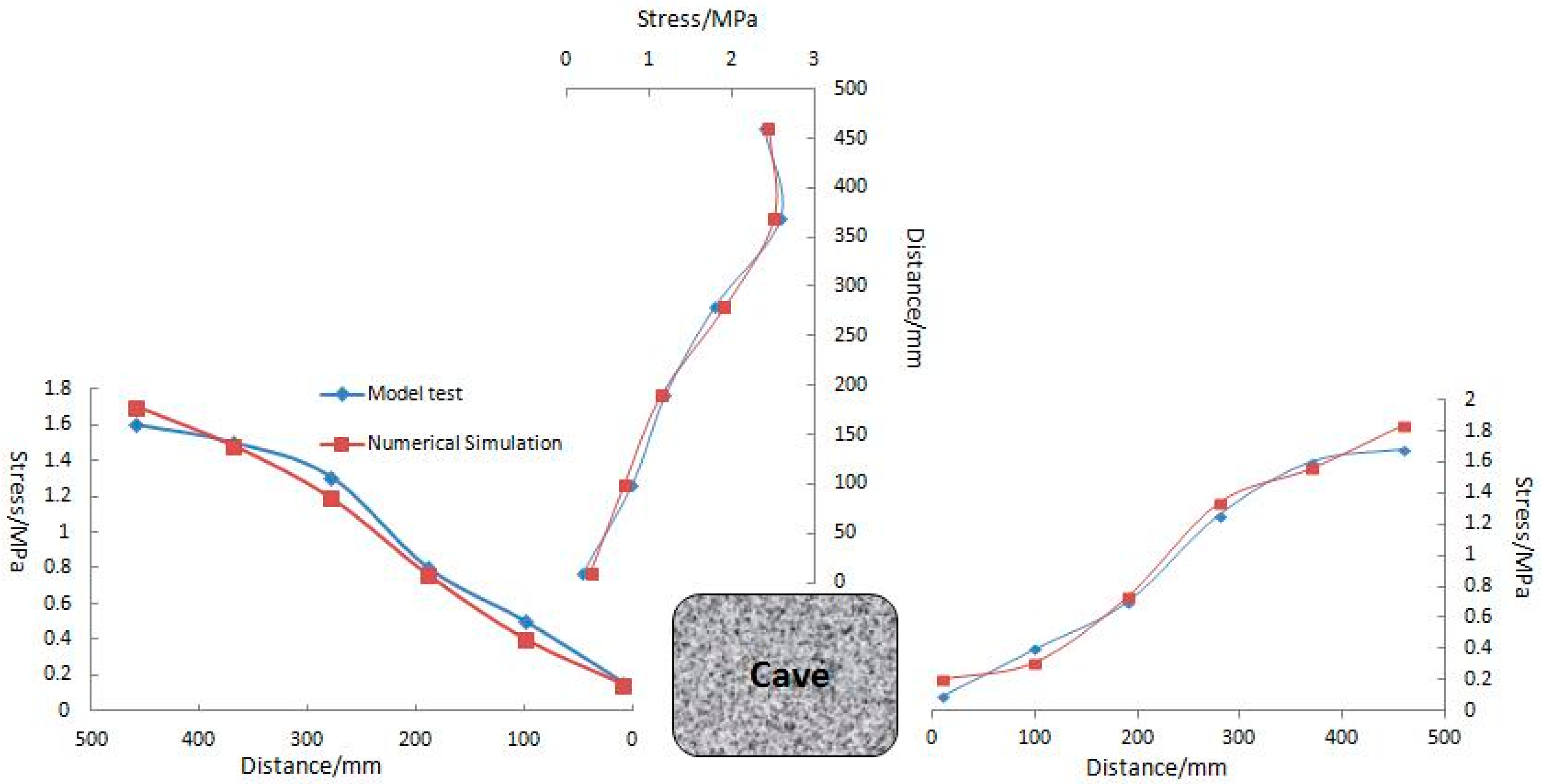
| Bulk Density (KN/m3) | Poisson Ratio | Elasticity Modulus (MPa) | Compressive Strength (MPa) | Friction Angle (°) | Cohesive Stress (MPa) |
|---|---|---|---|---|---|
| 27 | 0.25 | 36,300 | 74.2 | 36.05 | 2 |
| Bulk Density (KN/m3) | Poisson Ratio | Elasticity Modulus (MPa) | Compressive Strength (MPa) | Friction Angle (°) | Cohesive Stress (MPa) |
|---|---|---|---|---|---|
| 26.8–27.1 | 0.23–26 | 710–820 | 1.38–1.61 | 35.4–36.5 | 0.23–0.26 |
| I:B:S 1 | Rosin-Medical Alcohol Solution Concentration (%) | Percentage of the Rosin-Medical Alcohol Solution (%) |
|---|---|---|
| 1:0.67:0.25 | 17 | 6 |
| Measure point on the top | Distance to the top (mm) | 10 | 100 | 190 | 280 | 370 | 460 |
| Top replacement (mm) | 5.69 | 5.6 | 5.5 | 5.62 | 5.65 | 5.29 | |
| Measure point on the left wall | Distance to the left wall (mm) | 10 | 100 | 190 | 280 | 370 | 460 |
| left wall replacement (mm) | 3.8 | 1.2 | 0.9 | 0.2 | 0 | 0 | |
| Measure point on the right wall | Distance to the right wall (mm) | 10 | 100 | 190 | 280 | 370 | 460 |
| right wall replacement (mm) | 2.9 | 1.5 | 1.3 | 0.1 | 0 | 0 |
| Measure point on the top | Distance to the top (mm) | 10 | 100 | 190 | 280 | 370 | 460 |
| Top stress (MPa) | 0.2 | 0.8 | 1.2 | 1.8 | 2.6 | 2.4 | |
| Measure point on the left wall | Distance to the left wall (mm) | 10 | 100 | 190 | 280 | 370 | 460 |
| left wall stress (MPa) | 0.16 | 0.5 | 0.8 | 1.31 | 1.5 | 1.6 | |
| Measure point on the right wall | Distance to the right wall (mm) | 10 | 100 | 190 | 280 | 370 | 460 |
| right wall stress (MPa) | 0.1 | 0.4 | 0.7 | 1.26 | 1.6 | 1.68 |
© 2017 by the authors. Licensee MDPI, Basel, Switzerland. This article is an open access article distributed under the terms and conditions of the Creative Commons Attribution (CC BY) license (http://creativecommons.org/licenses/by/4.0/).
Share and Cite
Wang, C.; Zhang, Q.; Xiang, W. Physical and Numerical Modeling of the Stability of Deep Caverns in Tahe Oil Field in China. Energies 2017, 10, 769. https://doi.org/10.3390/en10060769
Wang C, Zhang Q, Xiang W. Physical and Numerical Modeling of the Stability of Deep Caverns in Tahe Oil Field in China. Energies. 2017; 10(6):769. https://doi.org/10.3390/en10060769
Chicago/Turabian StyleWang, Chao, Qiangyong Zhang, and Wen Xiang. 2017. "Physical and Numerical Modeling of the Stability of Deep Caverns in Tahe Oil Field in China" Energies 10, no. 6: 769. https://doi.org/10.3390/en10060769





